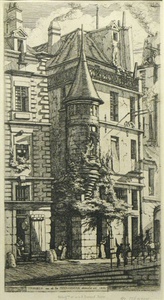| Method | Héliogravure |
| Artist | Charles Meryon |
| Published | c. 1870 |
| Dimensions | Image and Plate 248 x 131 mm |
| Notes |
Designed for his series of etchings entitled Eaux-fortes sur Paris. This print depicts a building at the angle of Rue du Coq, which was demolished in 1852. Obsessed with early architecture, which he regarded as possessed with the spirits of the past, Meryon was determined to preserve these buildings through a series of etchings. He introduced mediaeval characters to the scenes he engraved. From Meryon's own descriptions, it is clear that he really believed these characters to exist and depicted them as he saw them in his mind's eye. Charles Méryon (1821 - 1868), was a French artist, who worked almost entirely in etching, as he suffered from colour-blindness. He is generally recognised as the most significant etcher of 19th century France. He also suffered from mental illness, dying in an asylum. His most famous work is a series of views of Paris. Charles Amand-Durand's reproduction of Méryon's etching constitutes an interesting example of prints after significant artists and engravers. Like others before him, Armand-Durand attempted to democratise the art industry by reproducing the works of famed artists which were hidden in the repositories of the French National Library, or in the ownership of private collectors. His main series of facsimiles after Old Master prints began in 1869. They were usually published in portfolios, with accompanying text by Georges Duplessis. A high quality photograph would have been taken of Méryon's original work. The negative was then exposed onto a gelatin covered copper plate, and etched with acid. At this point, the photogravure would have been mechanically printed, but the technique of the héliogravure differs in that Amand-Durand continued to etch parts of the plate himself, and printed the works by hand. Somewhat paradoxically, Amand-Durand's works have become as esoteric as the artists that he sought to democratise. Charles Amand-Durand (1831 - 1905) was a French printmaker and publisher. He is best remembered as the pioneer of the héliogravure. Together with Georges Duplessis, he produced portfolios replicating the work of artists such as Dürer, Rembrandt, Claude and Lucas de Leyde. As with other publishers of the time, he printed his works on antiquated paper, so as to give the impression of the original. His works can however be identified by the red stamp which bears his initials on the verso. Schneiderman 24 v/v |
| Framing | unmounted |
| Price | £250.00 |
| Stock ID | 11245 |

